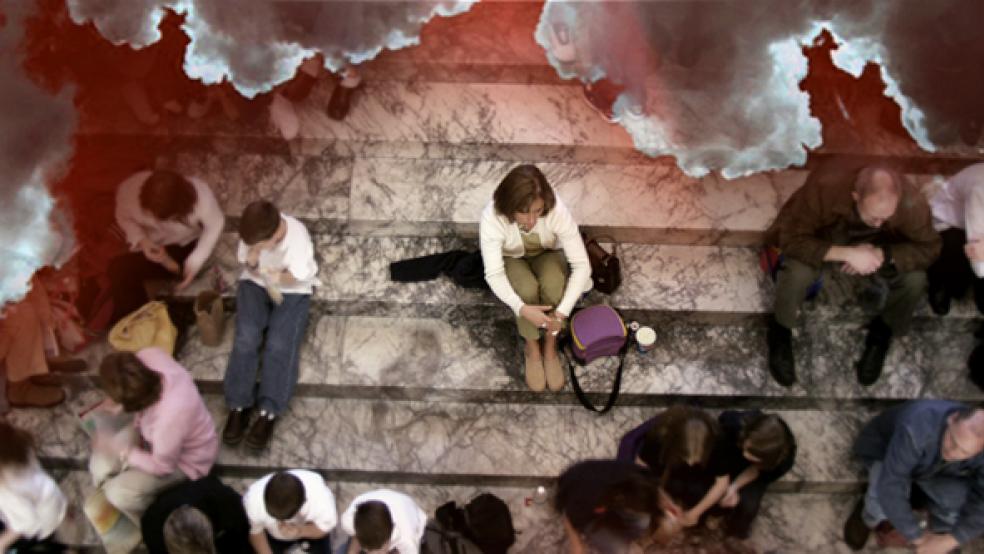Many states have announced higher-than-expected tax revenues lately, the first upbeat news to come out of beleaguered state budget offices since 2007. But the windfall is largely the result of smoke and mirrors. Revenue estimates for this year were set at ultra low levels, leaving plenty of room for good news.
The reality is that state budget problems are the worst they’ve been since the start of the recession. State tax revenues are more than 10 percent below their 2008 levels, and 44 states and Washington DC have been scrambling to close a collective $112 billion budget shortfall for fiscal year 2012, which for most states begins July 1.
The budget gap is dwarfed by last year’s $191 billion shortfall, but this is the first year since 2008 that states have to balance their budgets without federal aid. Stimulus under the American Recovery and Reinvestment Act, which pumped $137 billion into state budgets over the past three years, has essentially dried up for 2012, “and many one-time maneuvers to generate cash or delay expenditures have been used, so the budget gaps that have to be filled are now very real numbers,” says Harley Duncan, KPMG’s leader for state and local tax.
For taxpayers – already weary of rising taxes and cuts to critical services – the fiscal noose is tightening sharply as states resort almost entirely to deep spending cuts and tax hikes to balance their budgets.
Lawmakers in about half of all states are still hashing out the details of their budgets, but so far, here is how things are shaping up:
- Education budgets are taking a beating in about two dozen states, requiring a drastic scale-back in programs in many cases, according to the Center on Budget and Policy Priorities. As an example, for South Dakota’s largest school district, 10% cuts to K-12 education is tantamount to cutting all bus services, athletic programs and art programs.
Education budgets are getting so lean in Mississippi, Missouri and Nebraska that they are breaching statutory funding formulas – yet further cuts are being negotiated this year. And in New York, for the third consecutive year education cuts are on the table despite a court order to increase funding to schools that need it most.
In Texas, lawmakers grudgingly cut about $1 billion in education funding over the past two years from its already below-average education budget, and now another $1 billion is getting axed for higher education, which is expected to cause some community colleges to close their doors.
- About half of all states are cutting public health care, an area that is already stretched thin by previous cuts in 31 states and a spike in Medicaid enrollment induced by high unemployment. Services for mental health, abused children, the elderly and underinsured are the primary targets.
- Services to low-income families, already whittled down, will be cut even more. Funding for child care for working families is being targeted in California, Ohio, Louisiana, Georgia and Wisconsin.
California, Delaware, Michigan and Washington DC are among the most recent to slash benefits to families living way below the poverty line. South Carolina, New Mexico and Washington made similar cuts early in 2011. About 1.3 million children are affected.
- Public employees are taking it on the chin — again. Some 44 states have already cut 400,000 jobs since August 2008, and now 15 are zeroing in on further layoffs, pay cuts and a decrease in pension benefits.
- So far Connecticut and Hawaii have passed tax increases (a record-high increase in Connecticut), and governors’ proposals for hikes are being hotly debated in California, North Carolina, Illinois, Rhode Island and Minnesota. If the tax proposals don’t pass, the trade-off could be painful. In California, for example, community colleges may have to raise tuition by 38 percent, and funding for state universities could drop to 1998 levels.
States’ fiscal problems will ease somewhat once payrolls expand, corporate profits rise and consumers spend more. But an improved economy won’t cure all ills. “If there hadn’t been a recession, a lot of states would still be struggling to balance budgets,” Duncan says, adding that chronic weaknesses in their budget processes must be addressed to ever fully achieve fiscal health.
For example, many states are reliant on individual income taxes, which are highly volatile and unpredictable, making spending plans no better than shots in the dark. In California, for example, capital gains are the state’s biggest revenue source, but the numbers swing wildly: From $17 billion in 2007 to $5 billion in 2009, according to the Milken Institute, a California think tank. “This requires very quick adjustments to expenditures that the budgeting process doesn’t permit,” says Ross DeVol, executive director of the institute.
A solution is to expand the sales tax base so states are less reliant on income taxes, analysts suggest. The sales tax base has eroded over years as the economy has become more reliant on the sale of services rather than manufactured goods. Goods are subject to the sales tax, while many services are not. Online sales have also weakened the sales tax system, because states often can’t collect taxes on them.
Corporate income taxes could also be more reliable if tax loopholes were closed, he says, adding, “It would be hard to find a state that has a revenue system that couldn’t stand some modernizing.”
Short of reforms, however, many states could prevent fiscal disasters by building bigger rainy day funds, says Elizabeth McNichol, a senior fellow at the Center on Budget and Policy Priorities. While bond rating agencies like to see 5 percent of a state’s budget in six states had no rainy day funds when the recession started, and 21 had less than 5 percent set aside, says McNichol, who recommends 15 percent as a better target.
Some states also need to revise procedures for how the funds are used. In 12 states, rainy day funds are mandated to be replenished so quickly that the states haven’t been able to tap their funds to help balance their budgets.
The good news? Tax revenues are no longer in freefall – they’re starting a long climb back to their pre-2008 levels. And once they’re back, lawmakers, still with fresh memories of years like this one, may be inspired to make some lasting fiscal changes.
Related Links:
State Budgets: Echoes of the 'B' Word--Bankruptcy
Extreme Weather Batters State Budgets
Unemployment: Why Stimulus Has Not Created More Jobs





